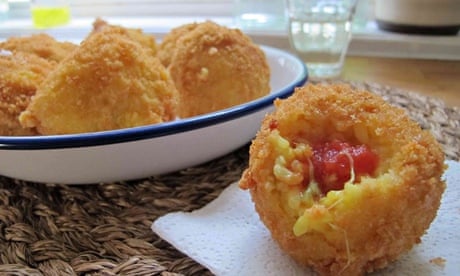Arancini - Sicilian leftovers
- rosemary
- Sep 24, 2021
- 5 min read
"anything you can enjoy in risotto, you can make into risotto balls."
Chef Paul (Paul Shufelt) - Edmonton Times

We tend to think of Italians as being rice eaters (risotto) in the North and pasta and pizza eaters in the south. Well at least in terms of tradition, not, of course, in terms of what people eat every day. The traditional dishes get served up to the tourists, and probably at home too, but everyone in Italy eats risotto and everyone in Italy eats pizza and pasta. Thus even though it therefore seems odd that arancini (rice balls) should be Sicilian we forget that Sicily has been heavily Arab influenced and therefore rice is not a surprise. They may even have been eating rice long before the northern Italians who are the ones growing it these days. For arancini are a very ancient food - dating back to the 10th century, which is when the Arabs were there.
Which made me wonder whether the Arabs did the same thing. Well not quite - they have kibbeh and variations thereof which are made with burghul, all across the Middle-east and probably north Africa too. It's:
"the same concept: a stuffing encased within a grain-based outer shell." Aylin Öney Tan - Hürriyet Daily News
Maybe they do it with couscous too. But why not with rice? After all, arancini are made with risotto - either deliberately made for the arancini or from leftover risotto. Now the Middle-Easterners may not do risotto but they do do various kinds of pilaff and pilaus. Why can't these be made into an arancini kind of thing?
And what about Scotch eggs? Not quite the same I know, but almost. Does the rest of the world do similar things?
But back to arancini.
The name, by the way, is a diminutive of arancia which means an orange. So 'little oranges', named for the shape and the colour which comes partly from the frying and partly from the saffron in the risotto, which is the traditional kind of risotto that is used. Mind you there is another distinct shape - shown at the top of the page - which is conical and said to represent the volcano Mount Etna by some.
Why am I talking about arancini? Well it's that dratted chicken and orzo again. I had a lot of leftovers some of which are in the freezer and may well get forgotten. Things go to die in the freezer unless it's fresh meat or frozen vegetables, or pastry. Anyway I extracted the chicken from the dish added a few other things and made pasties out of that for dinner on Tuesday. But I still had all the orzo. I knew that arancini were made with leftover risotto - I'm sure we have all eaten them as an appetiser in an Italian restaurant - so I thought I could probably do the same with the leftover orzo - which was, after all flavoured with lemon, tarragon, garlic, leeks, carrots and parsley. Tasty enough surely?
So I searched the net and my cookbooks for recipes and came to the conclusion that almost anything goes. The only thing that they had in common was the rice - well in the sense that it was rice - sometimes it was leftover risotto - of any kind, sometimes it was risotto specifically made for the arancini - most commonly a saffron risotto, sometimes it was just boiled rice - even ordinary long-grain rice in The Silver Spoon. And now that I think about it some people added things to the cold risotto like grated Parmesan, even ricotta too. I think I might even have seen someone adding the filling (I will come to the filling) to the rice mixture.
Actually there were three other things they had in common, The first of these was an egg and breadcrumb coating, though whether the breadcrumbs were toasted, fine or coarse was a whole other thing. The egg was universal (I think), though the first coat of flour was not. The second was the deep frying of the arancini - though even here some health conscious people baked them in the oven and some shallow fried them - like me, because I didn't want to use that much oil. And lastly there is the stuffing. There was always something stuffed in the middle of the rice ball, but what that stuffing was varied enormously. The most common were pieces of mozzarella, and a meat ragù with peas for some reason.
I decided to keep it simple and just added that Parmesan and some more herbs to the leftover orzo and placed a small piece of bocconcini in the middle. And as you can see I served them with tomato sauce and Bill Grangers, capsicum and parsley salad.
Like I said - they were OK - but I suspect the major attraction was the crispy fried exterior. But the cheese hadn't quite melted in the middle, and the orzo 'risotto' was still - well bland. They weren't that hard to do - I'm sure it's best if your risotto is cold, even chilled before you shape the balls by the way. Nevertheless I think that next time I have leftover risotto I'll just reheat it in the microwave and eat it for lunch.
Felicity Cloake had a go at the perfect arancini - the first picture below, and she does talk about some of the pitfalls and difficulties but here are a few more Jamie Oliver; Recipe Tin Eats; Guy Grossi and Hugh Fearnley-Whittingstall who seems to prefer a patty shape.
delicious. has half dozen or so offerings and Taste has around thirty, so there's no lack of inspiration out there.
Why are they such a thing? Well one theory is the popular Inspector Montalban series of detective stories both in book form and in a TV series, in which arancini are the detective's favourite food - an obsession almost. More likely though is the rise of the 'appetiser' on restaurant menus. They are a kind of snack food after all. In Italy and especially Sicily they are sold in bars and pasticcieri all the time, and especially at the festival of Santa Lucia in December when pasta and meat are banned. Here in Melbourne all those street food/snack food things are popping up everywhere - at large functions such as weddings and sports events, conferences and anniversaries as well as in restaurants. The Melbourne Food and Wine Festival has an ongoing series of snack foods from around the world. And arancini are just one of these.
At least nobody seems to be laying down the law on how arancini should be made.
This quote is marginally irrelevant but I liked it.
"There are even those who sustain that Milan’s signature dish of Saffron Risotto is nothing more than a poorly executed arancina that fell apart on a plate – the Milanese, of course, don’t agree." Roberta Schira - Fine Dining Lovers





















Comments